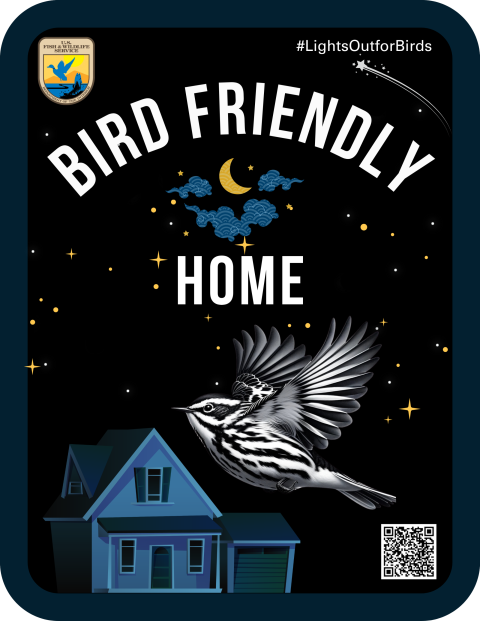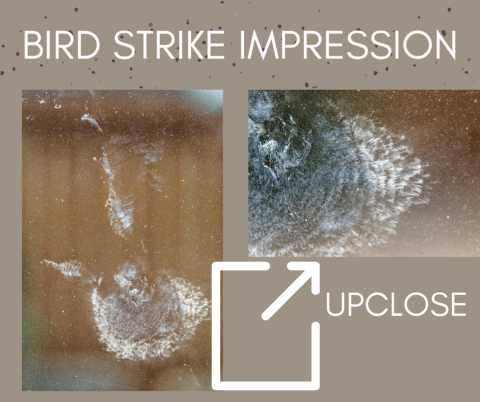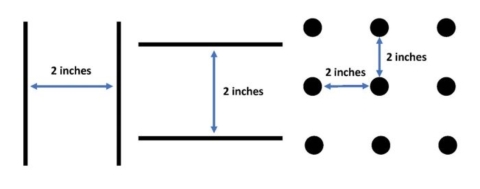About this Collection
Have you seen a dusty imprint of a bird on your window or heard the unsettling "thud" as they collide with glass at your home?
You are not alone! Every year, more than a billion birds collide with glass in the U.S., and most of these incidents occur at homes or other low-rise buildings. While some birds might seem fine after a collision, most eventually die later from injuries. Witnessing such events can be very upsetting. The good news?
There are actions we can all take to help protect birds from these preventable collisions! Even small changes can make a BIG difference for birds.
Birds collide at our homes because they struggle to see glass in our windows and can become deceived by reflections showing sky or vegetation. They are also attracted towards our homes when light shines out from the inside or upwards at night when they are migrating. Additionally, many birds commonly observed at feeders and birdbaths are among the most susceptible, including: warblers, thrushes, sparrows, hummingbirds, and vireos.
These three elements: glass, lights at night, and attractants at our homes, all need to be considered to fully address the threat of bird collisions. Let's get started!
Monitor Your Glass for Collisions
Pay attention to if you hear or see birds colliding with windows or other glass structures at your home.
Signs of collisions often include:
- a sudden "thud" sound as the bird strikes glass
- powder marks of a bird silhouette left behind on your window
- stunned or injured birds on the ground outside
Note: you may not always see these signs, as bird strikes often go unnoticed. It is reasonable to assume that if you are aware of occasional collisions, then additional collisions are likely also occurring.
If you can identify where birds are colliding most at your home, you can prioritize which windows to address first. However, it is best practice to make all of our glass windows bird-friendly to reduce collision risks as much as possible.
Consider bird-friendly window treatment options for the outside surface of glass, including (but not limited to):
Window Films: transparent films with patterns that are visible to birds but minimally intrusive to people's view. They can be applied directly to existing windows and are often removeable.
Window Decals: place decals on windows in patterns or shapes spaced 2-inch by 2-inch apart.
External Screens or Netting: this method can break up reflections and provide a physical barrier birds can see.
Zen Curtains: closely spaced vertical ropes or cords hanging in front of windows.
UV Reflective Glass or Coatings: some glass products or coatings reflect ultraviolet light, which birds can see but humans cannot, making the glass appear as an obstacle to birds without impacting the windows aesthetic.
Fritted Glass: small ceramic dots baked into the glass surface, creating patterns birds can detect and avoid.
One-Way Transparent Film: film that appears opaque from the outside, maintaining the view for people looking out.
Tempera Paint: get creative with washable window paints, but be sure your designs are spaced no farther than 2-inch by 2-inch apart across the majority of the window to be effective.
External Shading Devices: awnings, overhangs, and external blinds can reduce reflectivity, especially when the sun is low. Note: this method is not always as effective as the others.
Dim the Lights at Night
In North America, the vast majority of birds migrate at night between 10 PM and 4 AM during their peak spring and fall migration season. These night migrants rely on dark skies to navigate ancient flyways, using the stars and moon as their compass. As light pollution increases, millions of birds are becoming disoriented and exhausted as they are attracted in towards lights and lit structures at night.
Here is how we can help restore the starry night sky and reduce the threat of lights at our homes:
- Turn off unneeded lights.
- Close curtains or blinds at night to prevent light spill from the inside out.
- If outside lighting is necessary, opt for down shielded lights with motion sensors and timers.
When we make our glass more visible to birds, reduce our use of artificial lights at night, and close curtains or blinds at night, we not only help save birds, we also save energy, reduce costs, restore our night sky, and minimize the human health impacts of lights at night all at the same time!
Check for Attractants
- Homes with bird feeders and bird baths are more likely to attract birds closer to our windows and other threats like predators.
- Prioritize lights out and glass treatments in areas nearest to bird attractants.
- Keep bird feeders within 3 feet of windows to prevent a bird from building up enough momentum for a fatal collision.
Do you tell others about bird collisions with glass?
Be sure to share your conservation efforts with friends and family.
Inspire others on social media with #BirdSafeGlass, #BirdFriendly, #BringBirdsBack, #SafeSkies, and #LightsOutforBirds!
We can amplify our bird conservation efforts by increasing awareness and action within our communities. Let’s make bird conservation a social norm.




